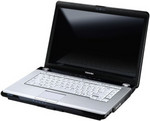Toshiba Satellite A200-180
Specifications

Price comparison
Average of 1 scores (from 1 reviews)
Reviews for the Toshiba Satellite A200-180
Source: Tech Advisor
 Archive.org version
Archive.org versionThe Toshiba A200-180 is more of a desktop replacement PC than a slim portable laptop that can be whisked from location to location. Its considerable bulk means you won't want to carry it for long distances, while its battery life is limited. The Toshiba Satellite A200-180 lasted for just 78 minutes in our intensive tests. There are, however, some nice features to compensate. With its 1.86GHz processor, the Toshiba Satellite A200-180 is reasonably powerful and, with the help of 1GB of DDR RAM, scored an acceptable 62 points in our WorldBench speed benchmark. You also get a nice range of connectivity options (802.11a, b and g Wi-Fi are all supported), while the 6-in-1 card reader and quartet of USB ports are extremely useful. In contrast to the Toshiba Satellite A100 we reviewed recently, a 1.3Mp camera is included, although there's still no Bluetooth. And, more surprising in light of the emphasis on multimedia, no TV tuner.
(von 5): 3.5, Preis/Leistung 4, Ausstattung 3.5, Verarbeitung 3.5
Single Review, online available, Short, Date: 07/05/2007
Rating: Total score: 70% price: 80% features: 70% workmanship: 70%
Comment
Intel Graphics Media Accelerator (GMA) 950: Intel Graphics Media Accelerator 950 is an integrated (onboard) graphic chip on Mobile Intel 945GM chipset. It is a faster clocked version of the GMA 900 and supports no hardware T&L (Transform & Lightning) accelleration (which is required for some games).
These graphics cards are not suited for Windows 3D games. Office and Internet surfing however is possible.
» Further information can be found in our Comparison of Mobile Graphics Cards and the corresponding Benchmark List.
Intel Core Duo: Double Core processor with a very good relation of performance to current consumption. The 2 MB L2 Cache are used together by the double. The maximum capacity of 31 watts is only 4 watts more than with the Pentium M (predecessor). Both cores are lowered automatically and independently of each other by speed steps down to 1 GHz. In addition it now supports also SSE3 instructions. At least it is just as fast as a equivalent Pentium M. With applications, which were designed for multi-processors, the performance can be nearly twice as fast as with the Pentium M (e.g. CineBench around 86% fast)
T2350: » Further information can be found in our Comparison of Mobile Processsors.




